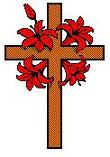Genesis_5_Ages_3_pic2b.jpg Genesis 5 Ages 3 intro.avi 1:26
 Hi,
Clark Nelson here with the video series: How to Understand
Genesis 5 Ages, number 3. Last time we met, I mentioned
the Primary Age term. Primary ages begin the
life of each named person in the lineage and extend until he
fathers, or Begets his next named son. Primary ages
for Adam and his son, Seth directly come from
the Holy Bible. Genesis 5:3 gives the primary
130-year age of Adam when he fathers Seth. Genesis 5:6
lists the primary 105-year age of Seth when he fathers
Enos.
Hi,
Clark Nelson here with the video series: How to Understand
Genesis 5 Ages, number 3. Last time we met, I mentioned
the Primary Age term. Primary ages begin the
life of each named person in the lineage and extend until he
fathers, or Begets his next named son. Primary ages
for Adam and his son, Seth directly come from
the Holy Bible. Genesis 5:3 gives the primary
130-year age of Adam when he fathers Seth. Genesis 5:6
lists the primary 105-year age of Seth when he fathers
Enos. Scriptures then assign each Antediluvian Patriarch another, second age. Secondary Ages last from fatherhood until death. Genesis 5:4 introduces the secondary age for Adam as 800-years.After Adam fathers his son Seth, Adam lives another 800-years. Seth continues 807-years in his secondary age after he fathers Enos from Genesis 5:7. Secondary ages follow primary ages to end the character's lifetime.
Understand_Gn_5_Ages_3b70pcb.jpg Picture with Adam scriptures:
Understand_Gn_5_Ages_3b70pcb.jpg Audio is HTU Gn 5 Ages 3b.mp3 voice over. 1:42
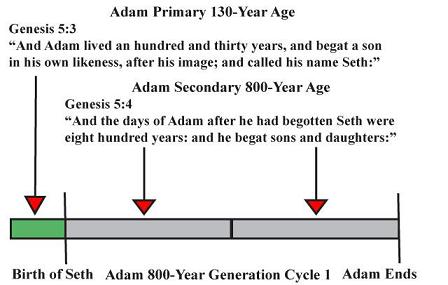 Adam's Primary
130-Year Age is the
left green rectangle that marks the birth of Seth.
Adam's Secondary 800-Year Age follows in gray until
he dies. Convention adds these two ages in linear order to
make 930-years the total lifetime age for Adam.
Adam's Primary
130-Year Age is the
left green rectangle that marks the birth of Seth.
Adam's Secondary 800-Year Age follows in gray until
he dies. Convention adds these two ages in linear order to
make 930-years the total lifetime age for Adam.
Adam's Secondary 800-Year Age is divided into two
periods of 400-Year Baktun Cycles. Adam 800-Year
Generation Cycle 1 terminology summarizes his
secondary age. We use Patriarch names and their
corresponding 800-Year Generation Cycle number to
identify repeating patterns.
Understand_Gn_5_Ages_3c70pcb.jpg Bar graph and first 800-year Generation Cycle 1 Calendar Tree diagram.
Audio is HTU Gn Ages 3c.mp3 voice over.
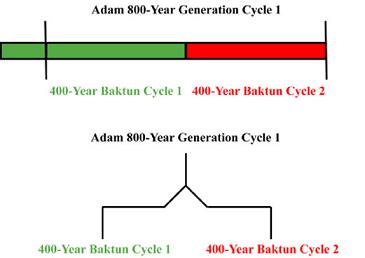 Adam 800-Year
Generation Cycle 1
terminology summarizes his secondary age. Adam's
Secondary 800-Year Age is colorized showing two
consecutive 400-year Baktun Cycles. Adam's first 400-year Baktun
Cycle is green. Adam's second
400-year Baktun Cycle
is red. Green is the
active color that
describes the first of two 400-year Baktun Cycles
in his secondary age. Red follows as the inactive color which occurs during the last half of Adam's
800-Year Generation Cycle 1.
Adam 800-Year
Generation Cycle 1
terminology summarizes his secondary age. Adam's
Secondary 800-Year Age is colorized showing two
consecutive 400-year Baktun Cycles. Adam's first 400-year Baktun
Cycle is green. Adam's second
400-year Baktun Cycle
is red. Green is the
active color that
describes the first of two 400-year Baktun Cycles
in his secondary age. Red follows as the inactive color which occurs during the last half of Adam's
800-Year Generation Cycle 1.Below the bar graph, Adam 800-Year Generation Cycle 1 is represented using a stick figure. Colorized green and red text are additional visual aids. Green text and graphics indicate active 400-Year Baktun Cycles. Active 400-Year Baktun Cycles generate respective green solar-side primary ages during the first of two 400-Year Baktun Cycles. Adam 400-Year Baktun Cycle 1 is the green first half of his repeating 800-year Secondary Age. Red text and graphics show the inactive, second 400-year Baktun Cycle 2. Primary ages for Adam and the other Patriarchs are designated solar-side values.
Author's note about colors: Green for Go, and Red for Stop introduce the idea of enabling solar-side ages. Succeeding generations use the same Green text and graphics for active Primary Ages in the Lunar/Solar 260-Year-Tzolken-Sacred-Cycle. Adam, Enos and Mahalaleeel comprise this group. Blue text and graphics replace Red text and graphics for inactive 400-year Baktun Cycles in later discussion involving these characters.
5-8-2013 Screen.avi 0:14, followed by Understand_Gn_5_Ages_3d80pcb.jpg 1:14
Animation separates Adam Primay130-year Age from Secondary 2 x 400-year Baktun Cycles, and hold.
Audio is HTU Gn 5 Ages 3d-1.mp3 1:29
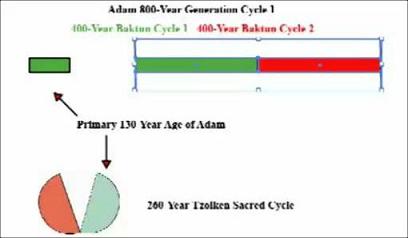 Lunar/solar
calendars involve reasoning to enable the ancient viewpoint of
time. Separating Adam's primary 130-year age
from his secondary 800-year age reveals original
lunar/solar components. Cyclic time meanings are different
from ordinary linear time. The primary
130-year age of Adam functions as a
masculine, solar-side time split or one half of an entire Lunar/Solar
260-year Tzolken Sacred Cycle. Imagine Adam
in the original generic Hebrew sense of the word. He was man
or mankind, made from reddish clay and given the breath
of life. He was created in the solar-side image of father God.
Lunar/solar
calendars involve reasoning to enable the ancient viewpoint of
time. Separating Adam's primary 130-year age
from his secondary 800-year age reveals original
lunar/solar components. Cyclic time meanings are different
from ordinary linear time. The primary
130-year age of Adam functions as a
masculine, solar-side time split or one half of an entire Lunar/Solar
260-year Tzolken Sacred Cycle. Imagine Adam
in the original generic Hebrew sense of the word. He was man
or mankind, made from reddish clay and given the breath
of life. He was created in the solar-side image of father God.
Secondary age 400-year Baktun Cycles, so long ago formulated, are an active cycle in our modern Gregorian solar calendar. Common Era (CE) reckoning is of course based upon 365-days, plus a leap day fraction every year. In 1582, Pope Gregory XIII instituted his namesake calendar reform to correct the gradual slippage of Easter into summer.
LS_4x2rr4_2pc75b.jpg Railroad tracks and 3 Time
Streams, 3 Faiths 1:45
Audio is HTU Gn 5 Ages 3d-2.mp3
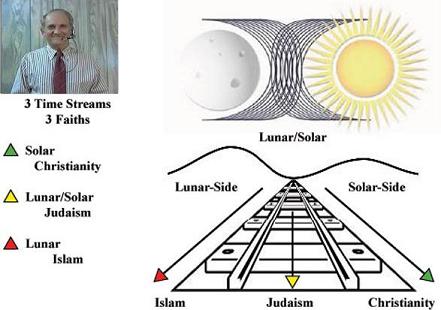 The solar
Common Era time stream traditionally aligns with
Christianity. Looking at the railroad analogy picture, the
calendar solar-side is marked with a green arrow pointing
forward in time. Most people know the leap day fraction
amounts to nearly a quarter-day every solar year. Leap
day accumulates time in a 4-year cycle and a
single day is added on February 29. There is another
less well known leap day provision involving the current
Gregorian calendar. Refinements stipulate that leap day
additions are omitted in those centennial years not evenly
divisible by 400-years. The year 1600 included a
normal leap day. Centurial years 1700, 1800 and 1900 omitted
leap days on February 29 to further correct the equinox
drift. In 2000, everyone added leap day in the usual manner.
Few people realized the important 400-year calendar
cycle had elapsed.
The solar
Common Era time stream traditionally aligns with
Christianity. Looking at the railroad analogy picture, the
calendar solar-side is marked with a green arrow pointing
forward in time. Most people know the leap day fraction
amounts to nearly a quarter-day every solar year. Leap
day accumulates time in a 4-year cycle and a
single day is added on February 29. There is another
less well known leap day provision involving the current
Gregorian calendar. Refinements stipulate that leap day
additions are omitted in those centennial years not evenly
divisible by 400-years. The year 1600 included a
normal leap day. Centurial years 1700, 1800 and 1900 omitted
leap days on February 29 to further correct the equinox
drift. In 2000, everyone added leap day in the usual manner.
Few people realized the important 400-year calendar
cycle had elapsed.
Christianity was affected by Gregorian reforms. Trends
during medieval era Protestantism were fueled by Gregorian
calendar modifications. Several Orthodox denominations
branched away from Roman Catholicism. Orthodox groups
continue to use the previous Roman Julian solar calendar
which lags the Gregorian by about 13-days.
 |
Understand_Genesis_5_Ages_3
Primary 130-Year Age of Adam is
given by Genesis
5:3 when he begets his next named son, Seth.
Adam's Secondary Age is the first 800-year
Generation Cycle 1. Mayan 400-year Baktun
Cycle 1 is shown with green text and graphics.
Railroad tracks analogy for solar and lunar/solar
time streams convey faiths. Third video in the
series.
Cart Item Gn5A3VT includes Video
3 download .mp4, 27 mb and this transcript PDF
download 604 kb
from Paypal-Payloadz for Only $ 1.98 |
V-27 mb T-604 kb 1.98 |
LS_4x2rr1SSa_1pc65.jpg Solar calendar time stream with a
green arrow for CE Gregorian. Audio is HTU Gn 5 Ages
3d-3.mp3 0:57
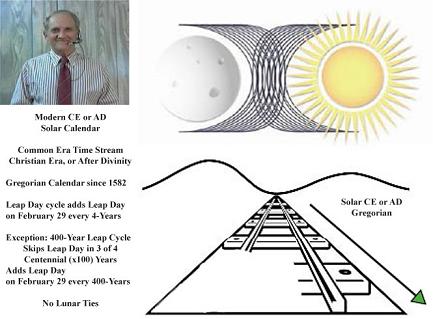 The green
arrowhead shown is a simple two dimensional representation
spanning some 7,000-years. At the most forward point,
the moment of now occurs with regard to the modern Gregorian
solar calendar. Gregorian reform dropped 10-days in
1582. October 4, 1582 was followed the next day by October 15,
1582. Later centennial leap day adjustments further aligned
the vernal equinox with Easter celebration. Moving backward
along the arrow's shaft condenses solar calendar development
into three segments. Our modern Gregorian solar calendar was
predicated by the Roman version, and the Egyptian before that.
The green
arrowhead shown is a simple two dimensional representation
spanning some 7,000-years. At the most forward point,
the moment of now occurs with regard to the modern Gregorian
solar calendar. Gregorian reform dropped 10-days in
1582. October 4, 1582 was followed the next day by October 15,
1582. Later centennial leap day adjustments further aligned
the vernal equinox with Easter celebration. Moving backward
along the arrow's shaft condenses solar calendar development
into three segments. Our modern Gregorian solar calendar was
predicated by the Roman version, and the Egyptian before that.
LS_4x2rr1SSb_1pc65b.jpg Picture with green
arrow for Roman Julian
Christian Era and yellow arrow for
lunar/solar inclusions.
Audio is HTU Gn 5 Ages
3d-4.p3 1:36
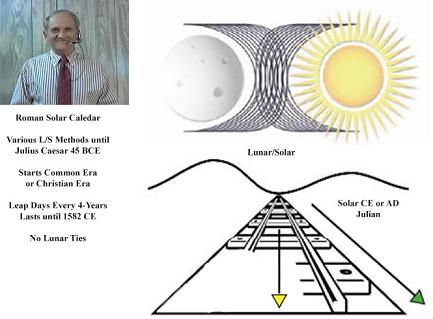 Julius
Caesar instituted his Julian solar calendar beginning in 45
BCE. As the Holy Roman Empire spread, the previous Egyptian
solar calendar was borrowed almost intact. July was named
after Julius and ordinary leap day additions ended February
every four years.
Julius
Caesar instituted his Julian solar calendar beginning in 45
BCE. As the Holy Roman Empire spread, the previous Egyptian
solar calendar was borrowed almost intact. July was named
after Julius and ordinary leap day additions ended February
every four years.
The Antediluvian Calendar of Genesis 5 incorporates lunar/solar 400-year cycles that synonymously refer to Mayan 400-year Baktun Cycles. Our modern Gregorian version follows a 400-year pattern that omits three of four leap days during centennial years. Time itself has not changed, only the methods of calendar layers are different.
Ancient Bible history was measured according to the lifetimes of Patriarchs and magnificent events that took place. Noah's life was immortalized by the Deluge and associated reckoning. Genesis 11 continues the dynastic story leading to Terah and Abraham. Years in the Old Testament were always counted using the lunar/solar calendar perpetuated by Judaism. Royal king lists and their families marked calendar legacy alongside sacred holidays observed.
LS_4x2rr1SSb_3pc70b.jpg The Time Tunnel picture
showing solar time stream green straight and curvy arrows.
Audio is HTU Gn 5 Ages 3d-5 3:13
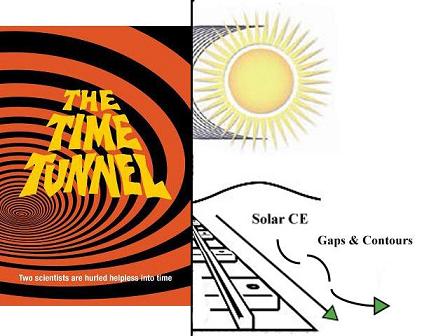
Multiple calendar gaps also happen in real world history. The Gregorian solar calendar reform of 1582 is one example. A transition occurred between the Julian and Gregorian. The solar time stream is apparent by defining absolute and relative chronology terms. Absolute chronology means the way people record their calendar. We use the modern Gregorian Calendar in our daily lives. Absolute chronology applies since we are the people doing the recording. Anyone before us also using Gregorian reckoning was part of the same absolute scale.
Relative chronology means the current interpretation based upon historical evidence whenever possible. In the late18th Century, Old Style (OS) notation signified the Julian Calendar and New Style (NS) stood for the Gregorian Calendar on historical documents. Writer convention bridged the absolute versus relative time gap. Anyone still using the older Julian Calendar for absolute dating was by default, implementing the Gregorian Calendar as relative chronology. The reverse was true if someone used the later Gregorian Calendar for absolute reckoning. The Julian Calendar thus becomes the relative instrument.
Religion contours the solar-side time stream by making wavy lines. No physical properties exist to guide or simulate spirituality. Christians usually choose to worship on Sunday. Other faiths select Saturday instead. Motivation has many reasons for determining worship standards. Larger groups sharing similar thinking often influence governmental actions. Counties may decide to allow alcohol sales on Sunday. Nations might give preference to religious causes.
LS_4x2rr4_2pc75b.jpg
Return to Railroad Rracks and 3 Time
Streams picture,
3 Faiths 1:45
Audio is HTU Gn
5 Ages 3d-6.mp3 1:23
 Any
picture that portrays a time stream and the calendar is
incomplete. Ideas about time in the extreme range from
wild fantasy to calendar science attempting to stitch
together parts of history. All 3 Time Streams: Lunar,
Lunar/Solar and Solar bear spiritual reflections of
the civilization served. The solar calendar time stream
shown begins linear record keeping with a penchant for
continuity over some 7,000-years. Calendar use
among three main time streams varies according to
prevailing religious doctrine and ruling politics. All
three arrows represent time moving forward at the same
speed. They emanate separate time streams within a larger
body beginning with 360-days per year. Three
different time streams act like separate currents in a
larger, flowing river. Multiple aspects of world
spirituality principally mark sacred commemoration.
Scientists would not have gotten lost in time back in the
60's had they known this kind of stuff!
Any
picture that portrays a time stream and the calendar is
incomplete. Ideas about time in the extreme range from
wild fantasy to calendar science attempting to stitch
together parts of history. All 3 Time Streams: Lunar,
Lunar/Solar and Solar bear spiritual reflections of
the civilization served. The solar calendar time stream
shown begins linear record keeping with a penchant for
continuity over some 7,000-years. Calendar use
among three main time streams varies according to
prevailing religious doctrine and ruling politics. All
three arrows represent time moving forward at the same
speed. They emanate separate time streams within a larger
body beginning with 360-days per year. Three
different time streams act like separate currents in a
larger, flowing river. Multiple aspects of world
spirituality principally mark sacred commemoration.
Scientists would not have gotten lost in time back in the
60's had they known this kind of stuff!
tags Genesis, Bible, ancient, Adam, Seth, Egypt, Jewish,
Mayan, Mythology, solar, lunar, Judaism (Religion), Spirit
Clark Nelson is webmaster for http://timeemits.com/Get_More_Time.htm, author of Ages_of_Adam and sequel, Holy_of_Holies. Original web content media by Clark Nelson and timeemits.com Copyright 2014 All Rights Reserved. URL http://timeemits.com/Scripts/HTU_Gn_5_Ages_3_Script.html
